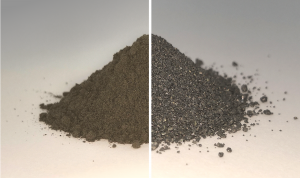On January 17th 2020, the materials and electrical components laboratory of the European Space Research and Technology Centre (ESTEC) in Noordwijk, Netherlands announced the launch of an oxygen plant: a facility designed to extract oxygen from moon dust. Using molten salt electrolysis, oxygen gas (O2) can be extracted from oxygen-rich compounds commonly found on the lunar surface. The ability to produce oxygen on the moon will benefit future lunar endeavors as oxygen is used for breathing and rocket fuel production.

Simulated moon dust before (left) and after (right) oxygen extraction by molten salt electrolysis. The byproducts (right) are metal alloys. (Credit: Beth Lomax, University of Glasgow)
Moon dust, formally known as moon regolith, is rich in metal oxides. Metal oxides contain metals with strong bonds to one or more oxygen atoms. These oxygen atoms require a significant amount of energy to liberate in order to produce oxygen gas. In molten salt electrolysis, simulated moon regolith is placed in a metal basket with calcium chloride (CaCl2) and heated to 950oC to melt the calcium chloride. An electric current is applied to the heated sample, producing oxygen gas and metal alloys.
The idea of making the most of lunar resources has been driven by space agencies’ (such as NASA and the European Space Agency) desire to start sending humans to the moon again, but this time with the intentions of staying and setting up a lunar base. The ability to self-sufficiently produce oxygen would be a vital asset to these missions, reducing the cost and urgency of supply missions to the moon. The metal alloy byproduct may also benefit lunar missions as ESTEC researchers now work on identifying the most useful components of the byproduct and their potential applications.
-Mark Rubinchik
